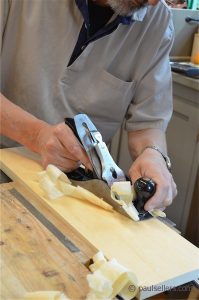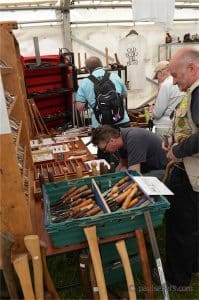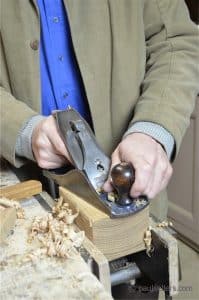Questions Answered – Do We Need a No 6 Plane?
For more information on planes, see our beginner site Common Woodworking.
Question
Hello Paul,
I’m learning quite a bit from your post and videos, thank you for making them available. I recently replaced my bench top of MDF to a laminated 2×4 with tool tray inspired from your tool bench series. Which brings me to my question I’ve gotten the top fairly flat with an ebay #4 plane but I’ve got my eye on a #6 I’ve not heard you comment on them would a # 5 be a better choice?
Answer


Seconhand tool dealers like Tony Murland are great guys to search out tools you need if you want a more guaranteed result than shopping on eBay
With regard to longer planes, these planes have a place in the workshop of any enthusiast. In fact, this week I have been prototyping a new bar stool design which will be made from hardwood for a book I am working on. The No 6 plane was the plane I used mostly because I needed elements to be trued as perfectly as possible. I use my components from the prototypes I make as reference pieces to develop the pieces for actual production whether this is for single production or batch production by machine methods.

So, on the one hand, no we don’t need longer planes for our general needs, but I do own every plane in the bench plane category and those by different makers like Stanley and Record. Because at the Castle workshop I don’t use machines normally associated with the conversion process, I tend to use longer planes. Mostly I can rely on my No5 and No 5 1/2. I can do everything with a No4, but sometimes I like the extra length and the extra weight too.
I know other craftsmen who like the longer planes for some of their work too. The quest for collecting a series from 3-8 is a natural one and one worth enjoying. I still do that, but 25 years ago I sold over a 2,000 hand tools through auction because I wanted to start in a different direction with my tool ownership. Now, every tool I have is a user.


Hi Paul,
Is there a use for a Panel Plane or does it already exist as a Numbered Plane, I never hear it mentioned, has it gone out of fashion?
Regards
Michael.
The closest to a panel plane is a #5 1/2 Bailey or Bed Rock plane in that they are weighty, long and wide. I have a panel plane but use it rarely. Some modern planes of the panel plane type are made by engineers who like to exemplify their craftsmanship in metal. They are truly beautiful. Whether you would want to use one at so high a cost as a couple of thousand and up would be personal. I could never justify those high costs myself, but different strokes for different folks.
That is a question I’ve been wanting to ask. Grace to your video’s and blog posts I’m really starting to enjoy hand tool woodworking. I’ve yet to start to build a workbench even. I’m still in the ‘gathering of proper tools’ stage. Since I’ll never will have the space nor funds to buy a thicknesser I was wonde ring if one of The larger planes could be a proper alternative.
Paul, I’ve got The impression that you seem to favor the smaller planes. Would that still hold if your jointer and thicknesser were out of order for a long time?
I think longer planes have their place, but I wouldn’t go past the #6, which is plenty long enough for anything you have need of a long plane for. If one came up for not much money I would but it. I just bought a #6 for $4.50. Peanuts really.
That may be a problem for me, good old stanleys or record or… are pretty scarce on the Europe mainland. Bringing them in from overseas will get the customs to charge me per weight instead of actual selling value to tax them.
I’ll keep hunting
I use my long planes a lot, but then I work a lot of rough-sawn stock, some of which I cut out of logs on my bandsaw. I would’t be without my #7, but I find that my #6 is an ideal shooting plane. I keep it around just for that.
Hi, I’ve just bought my first plane, a Stanley No.3 plane I found second hand. I’m wondering, can I do most of what you do with a No.4 or should I set my sights on one of those, or could I perhaps skip the 4 and aim for a 5 instead?
I would keep this and also eventually get the 4. You do fettle it exactly the same as the 4 so enjoy doing that.
RE. Paul’s reply, I have my Dad’s old #4 Marples set with the frog back & mouth open for rough-planing my greenwood blanks – works great. Then I use my Record #3, as my smoothing plane. Perhaps a similar set-up might work for Dennis?
I bought a Stanley 5-1/2 plane recently – not sure how that will fit in yet. I might end up with a smoothing plane that is larger than my scrub plane, as I am so happy with my #4 its current set-up that I have no plans to change it.
I’ve spent a few more years scrounging and now I have the 3½ (wasn’t a 3), a swedish #4½ I spent a lot of time fettling and restoring, a #5 and a #7. I paid between 5-40 euros per plane.
I personally found the 7 to be quite useful when I find I need it, which isn’t often, but when I do, I like having it. It’s a quite old Ohio Tools plane, might be pre-1900 even, brought home to Finland by someone returning from the US.
I am really satisfied with the swedish 4 Esteel model (equivalent to 4½ stanley), it took a lot of work over a year (I gave up and returned, months passed in between) and I did try the setting the chip breaker really really close many times over the years. It’s quite hard to get right, the chip breaker needs to be “just so” to work, and can have zero gaps. But when it does work, it’s a sweet payoff, just swoosh back and forth on tear-out prone wood and it handles it wonderfully. I use this plane the most now after I got it sorted out spring 2017.
I have also found I never really touch the frog on my smoother planes, I always set it as open as i can get it, as close as I have the chip breaker set, it won’t work otherwise and clogs up the mouth. With the 5 and 7 it’s another matter.
I do not know if I will acquire more planes after this, I have one of each and I don’t know if I would be served by acquiring more. I have as much as I use and don’t like collecting.
31/2? I’ve never heard of that size before. I find myself using my vintage Stanley 51/2 plane most these days, it just works so well! I suppose it is my new toy. 🙂
On holiday this year I bought an old wooden plane from outside a small antique store in Cornwall. It is in remarkably good, used condition and works brilliantly, £11. The irons are much thicker than modern Bailey plane irons. Set deep, it really hogs off wood quickly, but equally it can produce shavings as thin as any other plane. I am impressed. It feels a little light at the front after using Bailey planes. It is a little longer than the 51/2, so I’m guessing it would be considered a Jack plane.
I probably have more than enough planes now but I do use all of them. They each have their own character & uses. Even the tiny Hobby, England block plane which I thought at first was a non-working toy!
You are one of the only people who acknowledge the value of the #6. Moxon seemed to like them too though i am not sure of the extent of his woodworking experience like them. I like the feel of them in my hand. I have two Bailey #6s. One has grooves on the bottom and the other is a solid steel bottom. Are the grooves for ease of flattening?
The grooves are referred to as a corrugated sole and were to reduce friction because theoretically there is less surface contact with the wood. It was never a practical solution because it creates other issues such as shavings jamming in the grooves, trapped sawdust scoring the surfaces and marring the wood and such. Using it for roundovers and taking off arrises is less guaranteed because the grooves catch here too.
Regarding surface friction I made an oil pad as per Paul’s advice. That is to say the tightly rolled wad of cloth jammed into a small tin which is then soaked in oil. When the going gets tough and the sweat begins to form on the brow a quick wipe from the back to the front of the sole transforms the plane!
Amazing how hot the sole can get when it is binding.
With love from France.
Not sure if it’s okay to comment on old posts, but I just picked up a beat up old #6 from my grandpa. I had been asking about the history of my great grandpa’s old #5 which is becoming kind of an heirloom, and he just gave it to me. It’s a wonderful thing, but it’s also a little rough, it’s been welded across the top where it cracked or split, so the sides aren’t true, but I’m not certain that matters on these big planes? What I’m more curious about is do I need to put some time into checking the flatness of the sole, or if I can just clean up the blade and use it as is.
I love that you are using your Grandpa’s old plane and that it has some unique character. Treasure it. I get a real kick out of maintaining and using tools that were used by my father and grandfather. It reminds me of them and it feels like I am paying my respects to them. 🙂
I have not flattened the soles of my planes but I have been thinking about it recently. I don’t make fine furniture and it hasn’t really hampered me so far. Would be interested to hear Paul’s perspective (he has a youtube video on flattening planes).
Hi Paul, at my local market there are some No.4, 4½, 5 and 7 Stanley planes ranging from $30-40 NZD (about 17-22 GBP I think). If I were to purchase two, which would you recommend? No.4 and No.5? No.4 and No.7? Many thanks, love your site.
Definitely not the 7. Go for the 4 and 5 and if you can do it get the 4 1/2 as they come in for wider boards and faces of door stiles and rails.